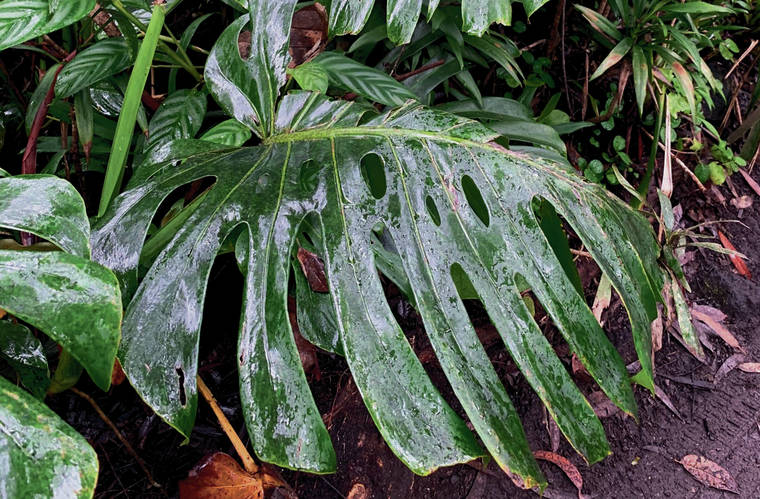
Mahalo for supporting Honolulu Star-Advertiser. Enjoy this free story!
Monstera, a popular icon of a tropical garden, is a rigorous climbing vine with monstrous leaves. But most people are unaware that the most commonly known species produces fruit that tastes like a cross between a banana and a pineapple.
“Its scientific name is ‘monstera deliciosa’. That tells you something — it’s delicious,” says Norman Bezona, a horticulture specialist for over 50 years in Hawaii. The catch is, eating the fruit when it is not fully ripe is extremely irritating to the mouth and throat, he said.
The bothersome characteristic is caused by calcium oxalate crystals, also found in taro when it’s not fully cooked, said Bezona, professor emeritus of the University of Hawaii College of Tropical Agriculture and Human Resources, and consultant to the Kona Cloud Forest Sanctuary.
The fruit looks like a cucumber with hexagonal scales. It doesn’t ripen all at once, but matures from one end to another. The little green scales, or platelets, at the base near the stem will peel off easily — pick the fruit at this point or the rats might beat you to them, Bezona said. He recommended putting it in a plastic bag with other fruit like bananas to produce the ethylene gas that will speed ripening. “They make great smoothies and things like gelato ice cream,” he said.
Monstera fruit is about 8-by-2 inches in size. Its platelets cover a white, soft pulp consisting of berries that adhere to a core.
One of its nicknames is “Mexican breadfruit,” according to a CTAHR report, and the “fruit salad plant” for its tastiness. It’s also known as the “Swiss-cheese plant” because of the pattern of holes in its large leaves.
During the inflorescence stage of development the fruit looks like the protruding spike of an anthurium, or spadix made up of lots of tiny flowers, accompanied by a white leaf-like spathe, Bezona said. It’s at this stage that together, the spadix and spathe most resemble an anthurium. (The monstera and anthurium are a part of the Araceae family.)
It takes a year for the fruit to fully develop, which doesn’t make it an economically feasible crop. Waiting for it to ripen is “a bit of a hassle,” which is probably why Native Hawaiians weren’t traditionally known to eat the monstera fruit and it hasn’t become part of the local culture as poi has, Bezona said. (His experience of the fruit was acquired in South and Central America, where it is a staple, as well as West Africa, the Caribbean and other islands of the Pacific.)
“Monstera does best in filtered shade and rich soil with ample organic matter,” the CTAHR report said. “It prefers a constant supply of moisture but does not tolerate waterlogging. It needs irrigation in dry areas. It tolerates low light and low humidity but is very susceptible to injury from soil salinity or wind-borne salt.
“This plant is unsurpassed for creating a tropical atmosphere, either outdoors or in interior landscapes. … It may also be used on a trellis or to cover walls and steep rock-cuts. Monstera makes a good bank cover for shady locations,” it said.
Bezona said monstera is highly tolerant of acid and alkaline soils, and a variety of conditions, but favors shade and moisture. More fruit is produced in sunnier parts of the garden, but it also needs shade about half the day.
—
Horticulture specialist
Norman Bezona can be reached at 808-325-6440 or bezona@hawaii.edu
Is there a gardening topic you’d like to read about in the Garden Variety column? Email Pat Gee at pgee@staradvertiser.com with your request.
"fruit" - Google News
July 18, 2021 at 05:10PM
https://ift.tt/3BbXWMl
Garden Variety: Monstera’s little-known fruit lies hidden among its leaves - Honolulu Star-Advertiser
"fruit" - Google News
https://ift.tt/2pWUrc9
https://ift.tt/3aVawBg
Bagikan Berita Ini














0 Response to "Garden Variety: Monstera’s little-known fruit lies hidden among its leaves - Honolulu Star-Advertiser"
Post a Comment